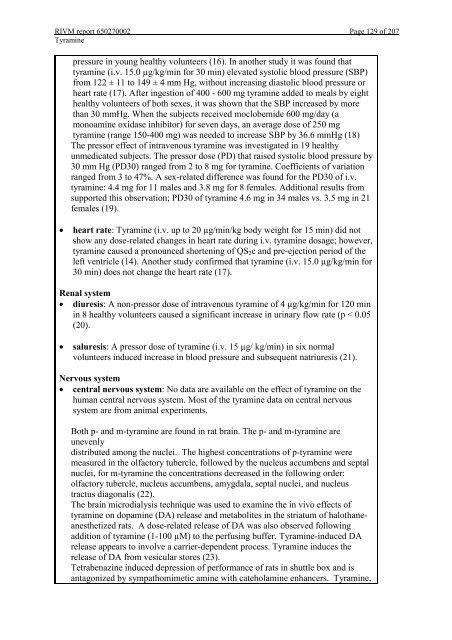The Contribution of cocoa additive to cigarette smoking addiction
The Contribution of cocoa additive to cigarette smoking addiction
The Contribution of cocoa additive to cigarette smoking addiction
You also want an ePaper? Increase the reach of your titles
YUMPU automatically turns print PDFs into web optimized ePapers that Google loves.
RIVM report 650270002 Page 129 <strong>of</strong> 207<br />
Tyramine<br />
pressure in young healthy volunteers (16). In another study it was found that<br />
tyramine (i.v. 15.0 µg/kg/min for 30 min) elevated sys<strong>to</strong>lic blood pressure (SBP)<br />
from 122 ± 11 <strong>to</strong> 149 ± 4 mm Hg, without increasing dias<strong>to</strong>lic blood pressure or<br />
heart rate (17). After ingestion <strong>of</strong> 400 - 600 mg tyramine added <strong>to</strong> meals by eight<br />
healthy volunteers <strong>of</strong> both sexes, it was shown that the SBP increased by more<br />
than 30 mmHg. When the subjects received moclobemide 600 mg/day (a<br />
monoamine oxidase inhibi<strong>to</strong>r) for seven days, an average dose <strong>of</strong> 250 mg<br />
tyramine (range 150-400 mg) was needed <strong>to</strong> increase SBP by 36.6 mmHg (18)<br />
<strong>The</strong> pressor effect <strong>of</strong> intravenous tyramine was investigated in 19 healthy<br />
unmedicated subjects. <strong>The</strong> pressor dose (PD) that raised sys<strong>to</strong>lic blood pressure by<br />
30 mm Hg (PD30) ranged from 2 <strong>to</strong> 8 mg for tyramine. Coefficients <strong>of</strong> variation<br />
ranged from 3 <strong>to</strong> 47%. A sex-related difference was found for the PD30 <strong>of</strong> i.v.<br />
tyramine: 4.4 mg for 11 males and 3.8 mg for 8 females. Additional results from<br />
supported this observation; PD30 <strong>of</strong> tyramine 4.6 mg in 34 males vs. 3.5 mg in 21<br />
females (19).<br />
heart rate: Tyramine (i.v. up <strong>to</strong> 20 µg/min/kg body weight for 15 min) did not<br />
show any dose-related changes in heart rate during i.v. tyramine dosage; however,<br />
tyramine caused a pronounced shortening <strong>of</strong> QS2c and pre-ejection period <strong>of</strong> the<br />
left ventricle (14). Another study confirmed that tyramine (i.v. 15.0 µg/kg/min for<br />
30 min) does not change the heart rate (17).<br />
Renal system<br />
diuresis: A non-pressor dose <strong>of</strong> intravenous tyramine <strong>of</strong> 4 µg/kg/min for 120 min<br />
in 8 healthy volunteers caused a significant increase in urinary flow rate (p < 0.05<br />
(20).<br />
saluresis: A pressor dose <strong>of</strong> tyramine (i.v. 15 µg/ kg/min) in six normal<br />
volunteers induced increase in blood pressure and subsequent natriuresis (21).<br />
Nervous system<br />
central nervous system: No data are available on the effect <strong>of</strong> tyramine on the<br />
human central nervous system. Most <strong>of</strong> the tyramine data on central nervous<br />
system are from animal experiments.<br />
Both p- and m-tyramine are found in rat brain. <strong>The</strong> p- and m-tyramine are<br />
unevenly<br />
distributed among the nuclei. <strong>The</strong> highest concentrations <strong>of</strong> p-tyramine were<br />
measured in the olfac<strong>to</strong>ry tubercle, followed by the nucleus accumbens and septal<br />
nuclei, for m-tyramine the concentrations decreased in the following order:<br />
olfac<strong>to</strong>ry tubercle, nucleus accumbens, amygdala, septal nuclei, and nucleus<br />
tractus diagonalis (22).<br />
<strong>The</strong> brain microdialysis technique was used <strong>to</strong> examine the in vivo effects <strong>of</strong><br />
tyramine on dopamine (DA) release and metabolites in the striatum <strong>of</strong> halothaneanesthetized<br />
rats. A dose-related release <strong>of</strong> DA was also observed following<br />
addition <strong>of</strong> tyramine (1-100 µM) <strong>to</strong> the perfusing buffer. Tyramine-induced DA<br />
release appears <strong>to</strong> involve a carrier-dependent process. Tyramine induces the<br />
release <strong>of</strong> DA from vesicular s<strong>to</strong>res (23).<br />
Tetrabenazine induced depression <strong>of</strong> performance <strong>of</strong> rats in shuttle box and is<br />
antagonized by sympathomimetic amine with cateholamine enhancers. Tyramine,
















